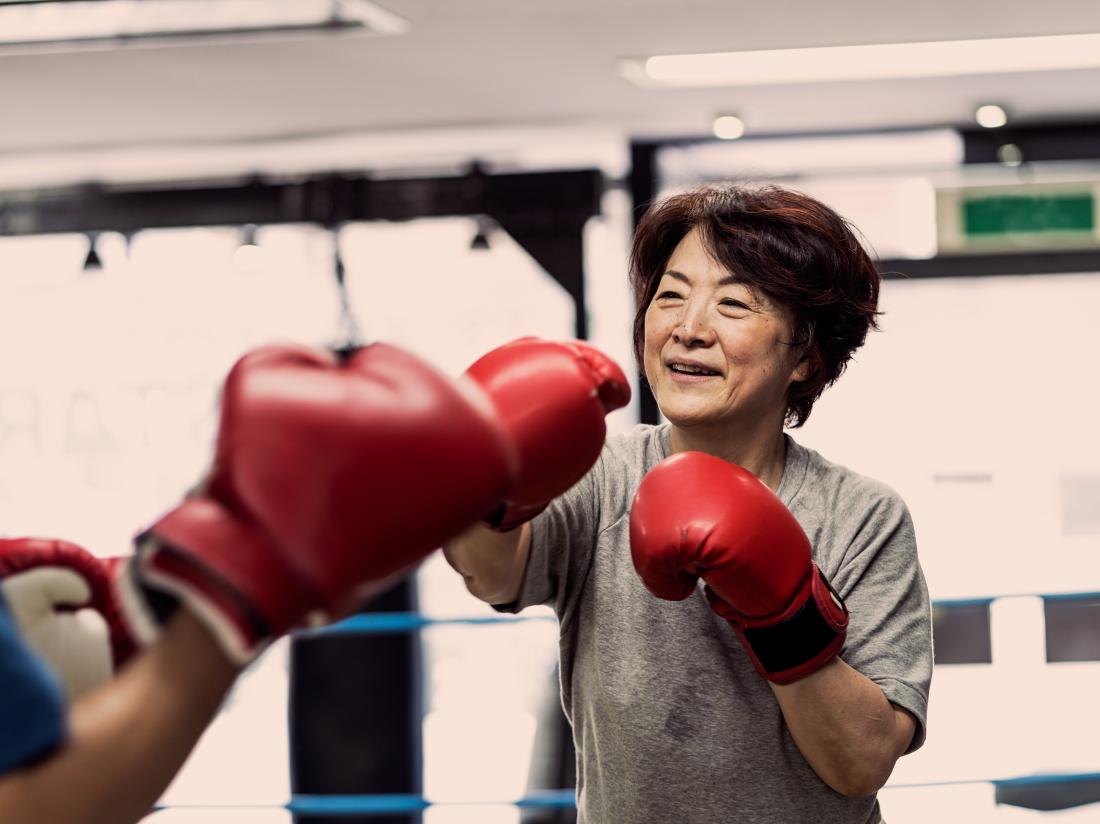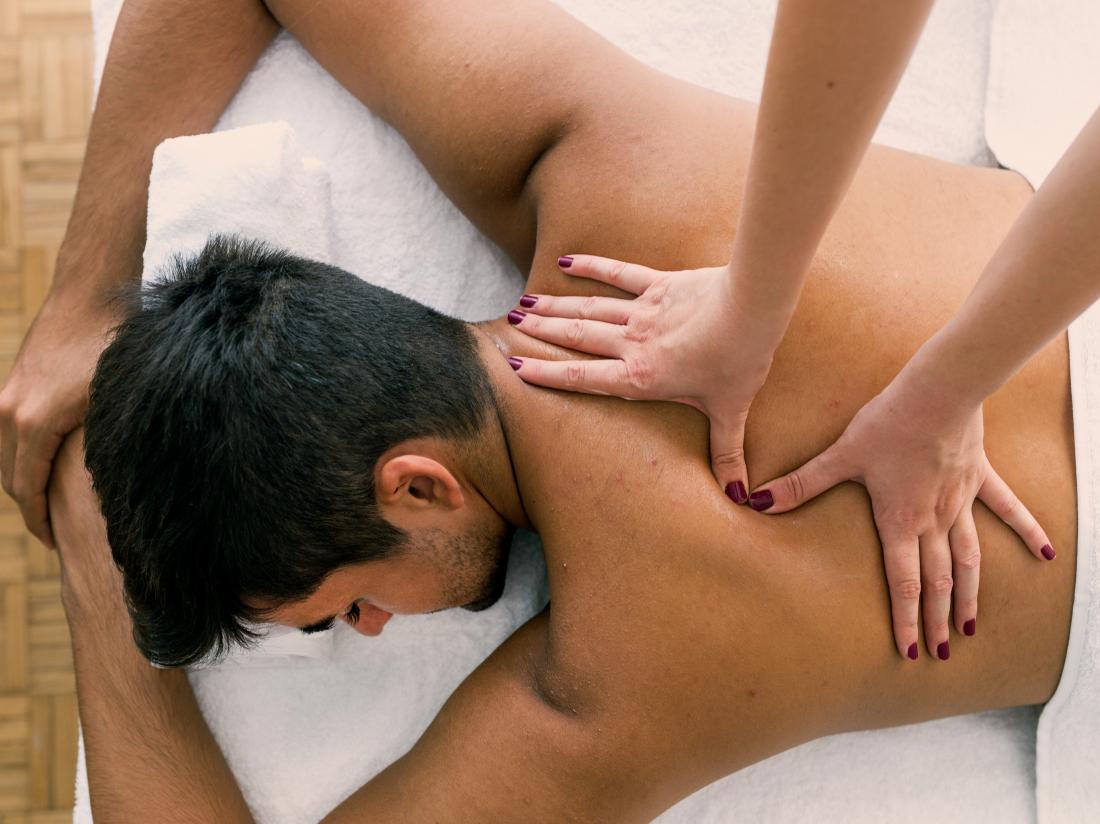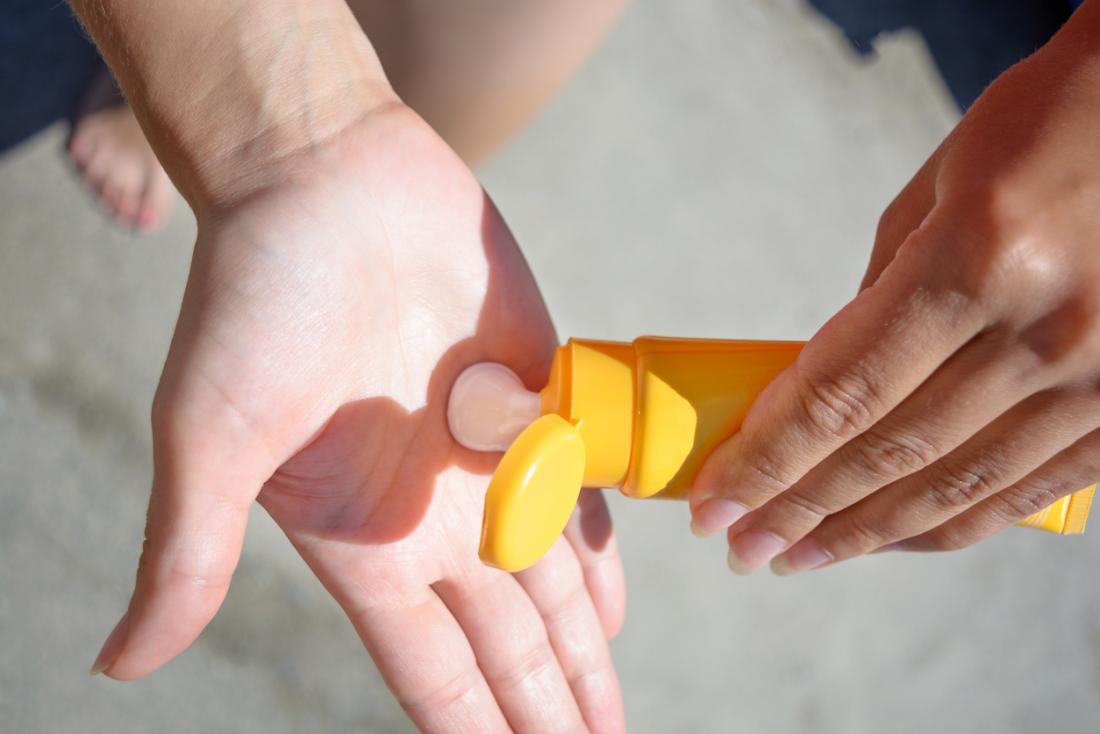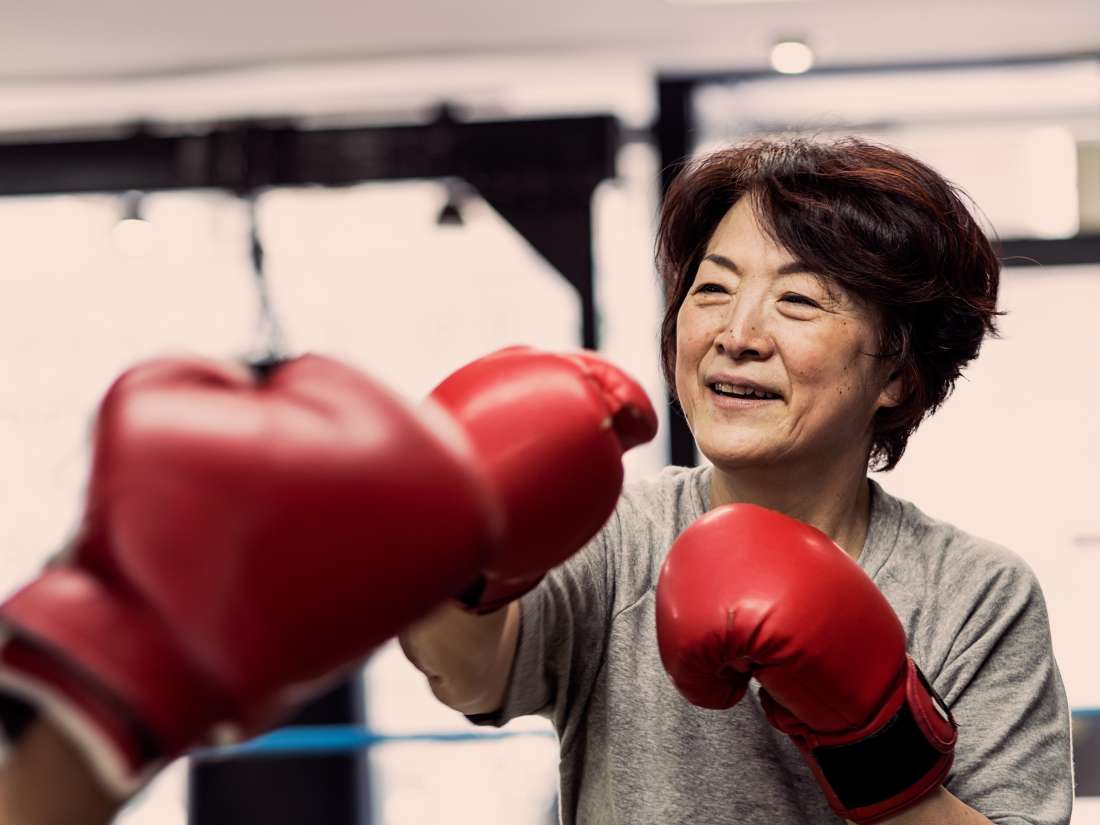Most people start to experience skin laxity, or loosening, between the ages of 35 and 40 years. Skin laxity that occurs with age is mostly due to a loss of collagen networks, elastin fibers, and hyaluronic acid — a molecule that helps the skin retain moisture.
Weight loss, especially significant or rapid weight loss, and pregnancy can also loosen the skin by stretching skin molecules or changing the structure of the skin.
Several other health and lifestyle factors can also contribute to loose skin, including:
- menopause
- ultraviolet (UV) light damage
- artificial tanning
- certain medications, such as steroids and corticosteroids
- skin products or detergents that contain harsh chemicals
- smoking
- drinking alcohol
In this article, we discuss popular techniques for tightening loose skin and ways to prevent the skin from sagging.
1. Exercise

Regular exercise may help skin age well.
Exercising regularly is an important way to stay healthy and age well. Some types of exercise may also help reduce the effects of skin aging.
A 2015 study found that endurance exercise might lessen the effect of age-related skin changes in mice and humans. The authors noted that endurance exercise reduced skin changes by improving tissue metabolism, primarily by stimulating the release of a hormone called interleukin-15 from skeletal muscle.
Women who have loose skin as a result of pregnancy should talk to a doctor about the best way to engage safely in physical activity and which exercises to avoid.
2. Firming products
Many different firming gels, creams, patches, and other products are available for the topical treatment of minor cases of loose skin.
People who wish to purchase a firming product should look for products containing retinoid compounds. Retinoids are potent antioxidants that may boost collagen production.
However, experts do not consider firming products to be effective overall, and their penetration of the skin may not be deep enough to help lift sagging skin.
According to the American Academy of Dermatology, most firming products offer subtle results at best, mostly by acting as a moisturizer. People who do observe results with these products may need to keep using them to continue seeing results.
3. Supplements
Diet plays a significant role in skin health. Nutritional supplements may have benefits for loose skin, including anti-aging and antisagging effects. Some of the most promising skin supplements include:
Collagen hydrolysate
Many people think that collagen supplements reduce the effects of skin aging by boosting collagen levels.
Collagen peptides in the form of an oral supplement may improve:
- the skin’s moisture barrier by increasing hyaluronic acid levels
- collagen production, leading to stronger collagen networks
- the growth of skin fibroblasts — cells that help make connective compounds
- wound healing
A study that featured in the Journal of Cosmetic Dermatology found that women who consumed 10 grams of oral collagen peptides in a drink at bedtime experienced improved skin collagen levels and overall structure after 4 weeks. Furthermore, they experienced better skin hydration levels after 8 weeks.
Antioxidants
Antioxidants and antioxidative enzymes may help reduce skin sagging and wrinkles by neutralizing reactive oxygen species (ROS). ROS are compounds that can activate pathways that eventually degrade collagen.
Antioxidants can also help stimulate the growth of collagen and elastin.
Examples of the antioxidants present in some foods, drinks, and nutritional supplements include:
Many people get enough antioxidants through their diet. There is little evidence to suggest that taking antioxidant supplements helps prevent or reduce skin conditions.
Taking too much of certain vitamins for too long, particularly vitamins A and E, may cause side effects, including nausea, vomiting, and abdominal pain. In some cases, it can lead to more severe side effects.
It is important to follow the dosage on the label when taking supplements. People with a health condition should discuss taking supplements with their doctor first to prevent unwanted side effects or interactions with other medications.
4. Massage

Massage may improve blood flow, stimulate fibroblasts, and increase mitochondrial production.
Massage may improve blood flow and stimulate fibroblasts. Fibroblasts are cells that help produce connective tissues, such as collagen and elastin, that keep skin firm.
Some studies suggest that massage may increase mitochondrial production. Mitochondria play a crucial role in tissue and cellular metabolism, and there is a link between mitochondrial dysfunction and skin aging.
More research is necessary to establish how best to use massage to tighten the skin. A 2017 study found that using a mild skin massage device for 1 minute twice daily for 10 days increased the expression of skin molecules, such as procollagen-1, fibrillin, and tropoelastin.
The same study also found that using the massage device after applying a commercial anti-aging cream to the face and neck amplified the product’s effect.
5. Nonsurgical procedures
Dermatologists and cosmetic surgeons can perform nonsurgical procedures that may help reduce loose skin. However, these procedures are not useful for severe cases of loose skin as the results tend to be subtle.
Nonsurgical procedures do not involve any cutting or punctures and typically only cause temporary swelling and redness. They often take only a short amount of time to perform.
Most procedures are safe for use on all skin colors and suitable for any part of the body.
Many nonsurgical procedures treat loose skin by boosting collagen and elastin production in different layers of the skin, usually by using various devices to send heat under the skin.
Examples of nonsurgical procedures include the following:
Ultrasound
Ultrasound works on the deepest layers of the skin. Most people notice subtle lifting and tightening within 2–6 months of their first treatment and report more significant results with additional treatments. The effects of the treatment can last for up to 1 year.
Laser treatments
Laser treatments focus on the outer layer of the skin, which is called the epidermis. Most people need between three and five treatments to see results, and changes are usually visible 2–6 months after the last treatment. Laser treatments are especially useful on the upper arms and belly.
Nonsurgical radiofrequency
In the nonsurgical form of radiofrequency, a dermatologist will place a device against the skin to heat the tissue underneath. Most people who use this method see results after one treatment.
It takes about 6 months for the treatment to take full effect, but some people notice tightening shortly after the procedure. With the right skin care, the results may last for 2–3 years.
6. Minimally invasive procedures
Some slightly more invasive procedures, which often use similar science or devices as nonsurgical procedures, may help reduce loose skin.
Examples of minimally invasive procedures include those below:
Surgical radiofrequency
The minimally invasive form of radiofrequency involves inserting tiny tubes through small incisions in the skin to send heat to the areas that require tightening.
Doctors often perform this procedure on the neck or upper arms, and it may produce results within 1 month. This procedure usually takes place under local anesthesia, and most people need to wear compression bandages for 4–5 days afterward.
Intense pulsed light
People often undergo treatment with intense pulsed light in combination with radiofrequency to treat the skin at different levels more effectively. A person may require a series of intense pulsed light treatments to see results, and it is sometimes unsuitable for those with darker skin tones or tanned skin.
Laser resurfacing
Laser resurfacing may be one of the most effective of all the nonsurgical and minimally invasive procedures for treating minor cases of loose skin.
Most people require 5–7 days of rest after the procedure and typically notice results 2 weeks after they heal. Laser resurfacing carries a small risk of scarring.
Can you prevent loose skin from appearing?

Practicing sun safety may help prevent loose skin from appearing.
In many cases, such as those relating to aging or hormonal changes, loose skin can be hard to prevent entirely.
Certain factors seem to make the skin more resilient and resistant to factors that may weaken and loosen it. Following specific advice may also help reduce the risk of excessive loose skin.
People can help prevent loose skin by:
Outlook
Loose skin is not harmful and does not require treatment, but some people dislike its appearance. The best way to tighten loose skin depends on the cause and severity of the symptoms and any additional health considerations.
In people with severe loose skin, surgery is likely to make the most significant difference.
Individuals with minor-to-moderate cases of loose skin may benefit from a range of options, including:
- exercise
- massage
- firming products
- nutritional supplements
- nonsurgical procedures
- minimally invasive procedures
Anyone concerned about severe loose skin should seek advice from their doctor.
